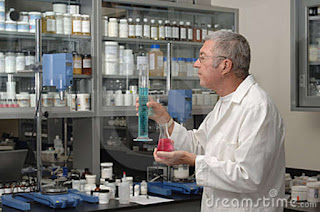The Ostwald process
The
Ostwald process is a chemical process which was developed by a German chemist
Wilhelm Ostwald in 1902(Yang et al. 1807). The Ostwald process is used in the
production of nitrogen-containing substances. It is mainly utilized in the
production of nitrogenous fertilizers and pharmaceuticals. The Ostwald process
is closely related to Haber process, which gives ammonia (NH3), a
raw material for the Ostwald process reactions (Liu et al. 1425). Ostwald
process is important chemical process since some chemical processes in the
industries are difficult to carry out by other methods. For example, nitric
acid is hard to produce on the industrial scale by other means, but through
Ostwald process, it is easier.
In
the initial step of Ostwald process, oxygen and ammonia gas react to form
nitrogen monoxide. This first reaction occurs in the presence of catalyst as
shown below:
The
reaction at this step is exothermic.
When the reaction is carried out at the laboratory level, then the hot
copper wire is used to catalyze it. In the commercial reaction,
Platinum-rhodium metal gauze is employed to catalyze the reaction. The gauze is
heated to 900
to
favor the forward reaction. The heat produced from the first of the Oswald
reaction is sufficient enough to keep the catalyst hot to maintain the reaction
(Cao, Chen and Cruso 11195).
In
the second step, one molecule of oxygen gas reacts with two molecules of
nitrogen monoxide gas to yield two molecules of nitrogen dioxide gas (NO2).
At this stage, the reaction is not catalyzed.
In
the final step, three molecules of nitrogen dioxide react with one molecule of
water (steam). The reaction produces two molecules of nitric acid and one
molecule of nitrogen monoxide gas. Nitric acid produced is separated from the
mixture by distillation. Nitrogen
monoxide gas formed is then recycled to step two of the Oswald process.
The
nitric acid produced through Ostwald process can now be used in the synthesis
of various nitrogen-containing compounds. For example, when ammonia gas reacts
with nitric acid, the reaction results in the formation of ammonia nitrate,
which is one of the nitrogenous fertilizers.
According
to Le Chatelier’s principle, the decrease in temperature favors forward
reaction. In step one of Ostwald process, the optimal temperature for maximum
yield of nitrogen monoxide is maintained at 600
. In an attempt to increase the temperature
of the reaction will force the reaction to respond in such a way to reduce the
temperature by producing more heat. This production of more heat favors
backward reaction (Fischer-Cripps 82). The
pressure of four to ten atmospheres is required for maximum production in the
reaction. The increase in pressure increases the movement of molecules
participating in the reaction thus leading to high yield. Increasing the pressure beyond this optimum
pressure will make the reaction to behavior in a manner which favors backward
reaction until the optimum pressure for the reaction is achieved (Le
Chatelier’s principle).
The
ratio of ammonia gas and oxygen on the catalyst (platinum-rhodium gauze) in
step one should be maintained at 10:100. For instance, ten molecules of ammonia
gas are reacted with 90 molecules of oxygen gas to favor forward reaction and
result in the maximum yield of nitrogen monoxide. Using any one of the
reactants in excess will lead to the explosion since the reaction reacts in a
way to favor backward reaction (Petrucci 110). The time contact of the air
mixture (NH3: O2) with catalyst should be short to
support forward reaction. If not, the principle of Le Chatelier's will apply.
The reaction will shift to the left-hand side of the reaction which leads to
the decomposition of the mixture into nitrogen gas (N2) and oxygen
(O2).
Ideal
conditions for maximum yield of the product are not used in many industrial
applications, due to the high cost associated with maintaining high pressures,
explosive that might occur in the process.
Work cited
Cao,
Lu, Dehong Chen, and Rachel A. Caruso. "Surface-Metastable Phase-initiated
Seeding and Ostwald Ripening: A Facile Fluorine-Free Process Tow ards Spherical
Fluffy Core/Shell, Yolk/Shell, And Hollow Anatase Nanostructures." Angewandte
Chemie 125.42 (2013): 11192-11197. Web.
Fischer-Cripps,
Anthony C. The Chemistry Companion. Boca Raton, FL: CRC Press, 2012.
Print.
Yang,
Hong Bo et al. "Ostwald Growth Of Carbides In Cyclic Annealing Process Of
Gcr15 Bearing Steel". AMR 374-377 (2011): 1805-1808. Web.
Petrucci,
Ralph H. General Chemistry. Toronto, Ont.: Pearson Canada, 2011. Print.
Liu,
Yang et al. "Fluorine-Free Synthesis Of Well-Dispersed Hollow Tio 2
Spheres Via Ostwald Ripening: Process, Mechanism, And Photocatalytic
Performance". Journal of the American Ceramic Society 96.5 (2013):
1421-1427. Web.








Comments
Post a Comment